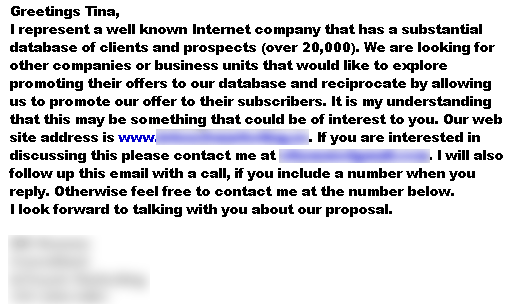15 Tips for Writing Effective Email
 Photo by
Lucia Holm
Photo by
Lucia Holm
Have you ever needed to email someone – a stranger, asking them for a favor? How can one compose email such that they will be read and responded to? How do we effectively email someone who gets a lot of email?
Whether personal or business, the ability to compose efficient and effective email is super useful – both in terms of productivity and responsiveness.
We’re all busy, and we’ve all received long, ambiguous and rambling email. Ironically, most of us have also been guilty of writing such verbose email while requesting for someone else’s time.
Now that I’ve had a little taste, on the receiving end of such email, it quickly became obvious which kind of email works and which do not. I have made some interesting and useful observations on effective email – particularly,
- What not to do when emailing someone (ie. a stranger).
- How to write email that people will actually (want to) read.
The point of this article is to share tips on how to approach people via email in the most efficient way possible, along with some common pitfalls on why some emails do not work.
Assumptions
Before we dive in, let’s lay out some assumptions:
- The recipient (person you are emailing) potentially gets a lot of email
- You need something from the recipient and plan on pitching it via email
- You either do not know the recipient, or she is an acquaintance, or she is a close friend and you’re asking for an unusual request.
Our goal is to construct email that:
- Will actually be read
- Will actually be understood
- Will not annoy the receiver
- Does not take up too much time on the receiver’s end.
Email Psychology
Generally speaking, the sender and receiver see things from drastically different points of views. And from the perspective of a sender, we often do not spend time understanding who the receiver is and what their inbox might look like. Let’s have a quick glance at both sides:
Observing the Receiver
- Gets a lot of email.
- May receive compliments regularly, if they are a public figure.
- Regularly gets asked a standard set of questions and favors.
- Does not have a lot of free time.
- Does not mind helping you, if it is fast.
Observing the Sender
- Spends a long time crafting the ‘perfect’ (-ly long) email.
- Believes that their request is original, unique, and special.
- Believes that they are the first to ask for such favors.
- Cannot imagine why anyone would turn them away.
- Desires to tell the whole story, explained from every angle, so that the listener can understand their point of view.
With such divergent perspectives, it’s no wonder receivers receive the kinds of email that they do, and that senders are wondering why their emails isn’t effective or eagerly responded to.
Now, putting ourselves in the perspective of a receiver (and we’ve all been there). When we are faced with going through an inbox full of email – coming back from a vacation for example, we have some natural habits that are worth noting:
- We tend to answer, or be drawn to email that are the fastest to answer or process. That means email that require very little work or thought.
- When we open an email that’s very long, our gut reaction is to close the email, or come back to it later when we might have more time.
- When we receive an email from someone wanting something from us, wanting us to buy something, or wanting our time, we instantly feel guarded and will automatically want to say no, even if the offer will benefit us in reality.
- We go through email while asking “what’s the point?”
- We go through email that is pitching something while asking “why should I care?”
15 Tips for Composing Clear, Concise & Responsive Emails

1. Determine Your Desired Outcome
Most people know roughly what they want, but do not take the time to clearly think it through. This is how we end up with ambiguous or rambling email. Without a clear understanding of our desired end results, our thoughts are disorganized and we can easily confuse the receiver.
There are 4 types of email:
- Self Fulfilling Email – The email itself is the point. You want to tell the receiver something, either a compliment or information. No reply is necessary.
- Inquiries – You need something from the receiver in the form of a reply. For example, advice, or questions answered. The reply is your desired outcome.
- Open-Ended Dialog – to keep communication lines open, for the purpose of some future result or benefit.
- Action Emails – The goal is not the reply, but some action on the part of the receiver. For example, a sales pitch, or asking for a website link exchange.
Which type of email are you sending? What is your desired outcome?
The clearer your intention, the more focused you will be, the better you can cater email for the intended result, the more likely you will get your desired outcome.
2. Quickly Answers, “What’s the Point?”
People want to know “what do you need from me?” Answer this question quickly. Skip long introductions, backgrounds, compliments and details. Jump to the point. State it clearly using minimal words.
If action is needed, make it clear what the desired action is from the recipient.
And if no action or reply is expected, say that! “No reply necessary.” It’ll be like music to their ears.
3. State Benefits Clearly
If a pitch is presented, make sure it includes many clearly stated, easily understood benefits for the receiver.
Too many pitchy emails focus solely on the sender and why the action will benefit the sender. If you don’t present incentives, or they are difficult to understand, the receiver will say no – resulting in a waste of time for both.
Also, make sure the incentives are realistic, the exchange is fair, and there truly are benefits to the receiver. Do your homework before contacting someone. Put yourself in their shoes, “Would you act on the offer?”
Example, emailing a high profile website like lifehacker for a link exchange is not a fair exchange. It’s called spam. If they don’t display links to other sites, likely they won’t display yours.
4. Remember to KISS
KISS = Keep it simple, stupid (I didn’t come up with this)
When we send out a long email asking for something from the receiver (time, favor, etc), we are essentially saying “I do not respect your time.” Show them you appreciate their time, by making email short, and simple to answer.
Using as few words as possible, introduce who you are, context if necessary, and why you are emailing.
Being brief doesn’t mean we have to be boring. We can be creative with our wording, add a dash of personality where you see fit, but still be brief.
5. Save the Whole Story – Stick to the Facts.
People tend to say too much in email. We feel compelled to describe all the details and disclose the whole of our existence so that the receiver can understand the whole picture. Truth is, unless you already know this person well, they really don’t care.
Unless asked, you don’t need to overly elaborate anything. Simply stick to the facts – it’ll help you keep your message short.
6. Pretend Face-to-face Intro
If you just met someone new at a party, would you open your mouth first and give them a rambling story about your life? Probably not. Typically, we close our mouth after a quick intro. In email, stopping talking is equivalent to hitting the send button.
Treating email introductions as if you are meeting them in person is another trick to keeping messages short.
7. Text Message Trick
When we are on mobile devices like the blackberry or our cell phones, we lack the fluidity of the computer keyboard, and as such, we get to the point really fast.
Now, pretend you’re on a mobile device, what would your message be now?
8. Avoid Excessive Compliments
Some people have the idea that the more compliments they throw out, the more likely the receiver will comply with their offer/need/pitch.
There is a difference between being genuine and saying what’s on your heart, and going out of your way to compliment someone. We humans are exceptional at detecting unauthentic phrasings and remarks – even in email.
Compliment only if you really mean it. And remember to be brief if you need action from the receiver.
9. Be Personal and Personable
Personalize email with relevant remarks to the receiver, put in a quick comment about their site, product or work. Address the person by name, sign email with your own name, and a friendly comment like “Enjoy your weekend!”
10. Make it Easy to Be Found
In your signature, include appropriate URLs for your website, blog, portfolio or product. Make sure the links are functional so they can read more about you in one-click.
11. Use Simple English
When the writing is too formal or uses irrelevant technical lingo, it is difficult for laymen to understand. Plus, you come off sounding like a legal document or spammer. Neither is good.
Write like you talk, using conversational English. Be authentic and realistic.
Trying to sound professional will come off as if you are trying to sound professional. Use your real voice – it’s more endearing and approachable.
12. Font Matters
There is nothing worse than opening an email and become blinded by the brightness elicited by all the words displaying in bold. It makes me want to instantly close the email for the sake of protecting my eyes.
Alternatively, fonts that are too small, too large, or otherwise hard to read (ie. 8 point, times roman font, all bold.) makes us not want to read the email as well.
Beware of your fonts in your ‘presentation’. Do not bold the entire email, use easy to read fonts (ie. Arial), and use a standard size. Do not use extravagant colors since they don’t work well on all monitors and can be hard to read.
13. Formatting Matters
Make emails easy to read and quick to scan by using bullet points, numbered lists, and keeping paragraphs short. Highlight keywords (bold or italic) for emphasis, without overdoing it.
14. Minimize Questions
Ask questions that matter, and limit the number of questions and favors you ask in an email (one or two max). The more questions (especially open-ended ones) asked in one sitting, the less likely you are to get a response, and the less likely all your questions will be answered.
Also, ask specific questions instead of a general open-ended ones. Be reasonable and thoughtful when asking. Don’t expect the recipient to solve all our life problems. For example, “How can I get rich quick? How can I become successful?” are too broad. Break them down into specifics and ask the one question that really matters.
You can send additional questions in separate emails. Key is in keeping the line of communication open by not overwhelming the receiver.
15. Trimming of Words
Like grooming a garden, read through the finished email and trim out words, sentences, and paragraphs that do not contribute towards your desired result.
Check for potential ambiguities and unclear thinking. Can you rephrase sentences for clarity using fewer words? Check for excess commentary that doesn’t add to the email’s main point. Remove extra details disclosed, unnecessarily.
Case Study:
This morning, I received this little gem in my inbox (bold and everything):
Subject: We Are Looking For Offers For Our Database

My first instinctive reaction was “What the *bleep*?” I actually stopped reading the moment the email flashed open, because my eyes hurt from the brightness of the bold fonts. My follow up questions were: What do you need from me? What the heck are you selling? Why should I care?
After reading it about five times, I’m still left confused as to what they do, or what action items I can take – aside from giving up my phone number (which I would never do).
Reviewing our 15 tips above, a more effective email might be:
Subject: Opportunity for Free Traffic
Hi Tina,
I’m writing on behalf of <web-url>. We make it easy for bloggers to network with one another.
Our site gets X monthly page views, just having your website listed in our network will expose it to many new readers.
Here are some websites currently in our community: <list of related and well known websites>.
Joining takes less than 5 minutes and you’ll love the results: <web-url>Let me know if you have any questions.
<name>
<company name>
<site url>
Take Home Points:
- No rambling stories or long intros.
- Get to the point quickly.
- Next action clearly stated.
- Present benefits.
- Fonts and formatting matter.
- Review for conciseness, simplicity and clarity.
- One question per email.
- Be yourself – that is, the concise version of yourself.
* What types of email annoy you, as a receiver? What tips do you have for keeping email efficient? Got ideas for writing ‘pitch’ emails? Share your thoughts and ideas in the comment section. See you there!













Awesome points, Tina! This is the one that stood out for me:
“8. Avoid Excessive Complements”
I can’t stand when someone lays the compliments on thick and then jumps straight to, “Now this is what I need from you.” Manipulation will get you no where with people. So I also try to be mindful of this when I DO compliment others. Even when I really AM being genuine, I try to tone it down if I think I’m being a little over the top.
Great read and great content. Thanks for sharing! Eric.
Hmmm… my quick response would be:
– I hit “delete” as soon as the title contains spammy words like viagra or dentist list :)
– Let’s say putting an objective, sender and location in the subject to make the recipient recognize the sender instantly.
What do you think?
Great topic & post! “Adding on to #15 – Trimming of words”
Since email has become such an important part of our daily communication it is important to realize “it’s not the same as talking to someone in person.”
Email lacks emotions, personality, and more importantly current moods, all of which you can pick-up when you’re standing in front of someone. Something you type can often be misconstrued and taken the wrong way depending “when you catch” the reader.
One way I stop myself from coming off the wrong way in an email is to not send it immediately after I type it. Waiting just 1 minute (longer if you have the time) and then re-reading it gives your mind a chance to reset and make sure your email conveys the appropriate tone.
How many times have you pressed “send” and second guessed the message you just sent? Take your time, it goes a long way.
Cheers,
Markus
http://www.myresveratrolexperience.com
I have struggled with my email usage over these past couple years. Some days I’m long winded and other days I Karate chop my way through (too quick and to the point). It’s finding that middle ground that eludes me.
I’m working on my skills and I must say that I’m much improved. I’m becoming happier with my responses.
Tina,
You’ve done a great job in this article addressing both sides of the equation – sender as well as the receiver of the email. It definitely made me consider the receiver’s perspective more. Great food for thought!
Thanks for the article.
Brilliant! I am going to bookmark this for future use. The sample e-mail was very effective and convincing.
One thing I both agree and disagree with is your point about formal language. “Cold mailing” for a job, as I have been known to do (and I have received several offers, and a great number of almost apologetic rejections that way), is not something I would do in an informal tone, for example. If the correspondence continues, of course, I follow the lead of the person I am writing to.
It certainly is always important to consider the perspective of the intended recipient. Successful communication is shared meaning and that isn’t going to happen without some consideration of other participant.
Short and to the point is also best. If a word isn’t absolutely necessary it shouldn’t be included. Afterward once contact is made one can get into details and protracted discussion but it pays to get “in” first.
Fantastically helpful article as always Tina! :)
Stephen
My interpretation of that email you are mentioning at the end of your post: It is a spammer that wants to get more email addresses for spamming. Hence: No response at all.
Here are some of my basic guidelines:
1. Don’t put it in an email if you’d be embarrassed if your mother read it.
2. Don’t put it in an email if you wouldn’t want your boss reading it.
3. Don’t put it in an email if you wouldn’t want it shared with the public (because it very well could be one day!).
I’d also suggest brevity, it works. Try it.
I think it is important to read your email carefully before sending it. Not just for typos etc. but to check how you’re coming across. You certainly wouldn’t want to be misunderstood.
KUDOS Tina: this post is clear, timely and helpful.
I really like the whole idea of being on a mobile device and sticking to the facts. How often do you tune out when someone who is completely disconnected goes into “their” story?
The type of email that annoys me are the emails that come without name (sender), all uppercase/lowercase, no paragraph, a lot of spelling mistakes and do not have clear intention.
Most of the time, I would just ignore them.
Hi
Glad you mentioned the questions in an e-mail. That is often I find where emails become frustrating.
If one asks more than one question, most of the time not all of them are answered.
What I do is list the question numerically. This increases the chances that they are all answered, but it is not guaranteed.
Juliet
Great article – I second all the comments so far, but will add my votes:
Brief and to the point is number one
Appropriate language number two – casual, formal, semi depending on your recipient
Check all links work correctly before sending
check spelling and grammer -: its not good for you’re image to make mistakes
Hi Tina,
These are great tips for writing an email. I just sent out some emails this morning and it is a waste that I didn’t read this article first.
Being concise and straight to the point really help in making the email easier to read for the receiver especially when the receiver is famous and receive tons of emails everyday.
Cheers
Vincent
Personal Development Blogger
The key to any e-mail is the subject line. Use it to summarize the message, make a personal appeal ( like including the recipients name e.g. David, why…) etc.
If your subject line doesn’t work, no one will ever open your message.
That is a very well written article. Definitely a great guide to constructing the perfect email. I’ll be using your tips and sharing them out to my coworkers.
Hey Chris,
You have noted an important point. The subject line is just like the title of a book. If the book has a compelling title, we are probably more incline to pick it up and read instead of a book with boring titles. I believe it works the same as as the subject line.
Cheers
Vincent
Personal Development Blogger
Tina, Thank-you.
After reading your post, I went back and ‘simped’ (simplified) a handful of mails I had sent this morning. Down to five lines.
I discovered this: I had been burdening others with information, as a way of avoiding the responsibility of making decisions myself.
Not brave, not effective. And not something I’m going to do any more.
Its so relaxing when people give me well-thought-out ‘yes/no’ choices.
I want to do that for others.
Tina, you are making my life more and more beautiful each month. (How good is it going to get?)
Again, Thank-you.
I’ve noticed these issues with long and not-so-organized emails. I tend to “leave them for later” like you said. That can sometimes mean a week or more before I answer. :/
When I write an email I try to keep it to a few lines, if at all possible. Bullet points help, but if the whole email is more than one page I don’t like it. ;)
Interesting! Thanks for the tips!
Wow, seems pretty complicated to me. You could just make sure your subject is something THEY are interested in and then make your message concise and about that.
Even better, don’t use email for something like this anyway, just phone them or talk to them in person.
Hey Nathalie,
I believe in listing points too. By listing points, we make the whole content easier to read. We tend to prefer listed points instead of paragraphs and this seems like human nature. :)
Cheers
Vincent
Personal Development Blogger
Thanks for the post “very helpful”
I made the mistake, of sending out and email to my list as a send all “instead of a BCC” big mistake, lost a couple of people.
Hi Tina, excellent post! Should be required reading for everyone who sends emails. I especially like your point to consider the receiver. I think everyone is inundated with email, whether they are famous or not and most of us have limited time to apply to reading and responding. I tend to browse long emails looking for key words to jump out at me and if none do, I hit the delete button.
Very well said Tina. I have definitely been guilty of the rambling email from time to time. I will keep your list close to my gmail and start my trimming down campaign tonight. Thanks.